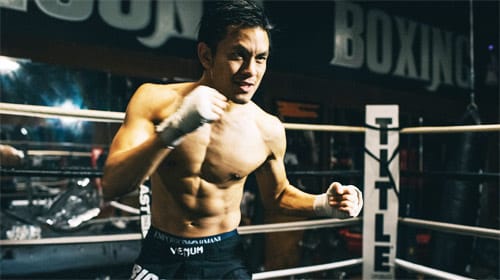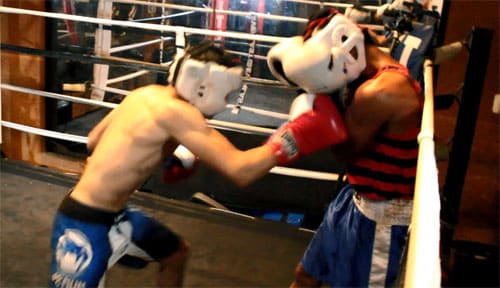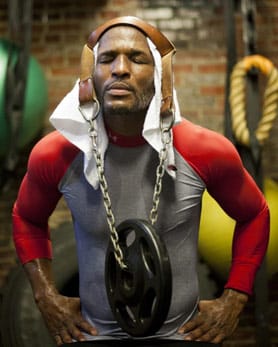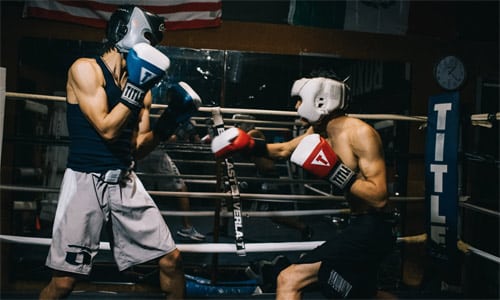One of my New Years resolutions was to finally answer ALL your favorite questions that’s ever been emailed to me.
So one of my New Years resolutions was to finally answer ALL the emails that I received over the past 2 years. I wanted to turn each one into its own article and post online so everyone could benefit but it took forever when I did it that way. I’m going to try a new format where I address numerous questions all at once and hope that you guys enjoy reading answers to your own questions as well as those of others’. I chose the best questions as well as the most common questions below for you guys.
Thank you all for writing me and giving me a chance to share my experience. It’s the questions you guys ask that keep me boxing in the gym to learn more and eager to share my findings with all of you. I’m sorry it’s taken over 2 years to answer some of these questions but I from here on out, I promise to reply much quicker. 
Happy New Year, everybody! Enjoy!
How do I beat a shorter boxer? – Rafael
Beating a shorter boxer is easier than beating the taller box. For starters, you can just run away from him and jab him to death. When you run away make sure your front foot is planted solid so that he can’t walk into your space and prevent you from planting a solid blocking stance. When he comes really close to you, walk into him and weigh him down with your shoulders and hips. Make sure you guard that body!
[Full Guide Coming Soon]
Can I Ever Get Good Just Training at Home?
About training at home, as long as you have people to train with you can always become better. While you might never be as good as someone who trains in a gym, you will certainly become good enough to enjoy the sport.
In my opinion, you should create a local boxing club with your own rules (have fun, not competition) and gather up some local kids. That’s what I did and we have a lot of fun with it over here. While nobody is world championship level, we all love boxing that much more. The most important thing is to have people and to have controlled sparring. As long as you are always sparring and thinking of new ways to attack/defend/counter/move, you will become better!
How Do I Counter My Opponent’s Right Hook?
If your opponent is throwing a lot of rights, there are a few options:
- Jab him to death. A straight jab usually beats a wild right. the trick is not to throw a power jab. leave your left extended a little and quickly reach out and tap his chin as soon as you feel he’s gonna throw that right hand. You’ll keep disrupting his rhythm.
- Wait for the right hand to land on you (block it, of course) and immediately throw a counter one STRAIGHT at him. Even if he leans back, as long as your counter right is straight and doesn’t loop you’ll be able to hit him. Don’t bother aiming or look, just throw as soon as you feel his right hand make contact on your gloves.
- You can walk forward into him every time he leans back to throw the right hand and then throw pushing jabs to his head or his front shoulder to knock him off balance. After he misses the off-balance right hand, land one of your own.
How Do I Punch in Different Angles? – Mavs
To get more punching angles you only have to do 4 things:
- Aim somewhere different – not always the same spot. Sometimes the top of the head, sometimes the bottom of the head… or the body. etc.
- Use a different kind of punch – instead of always straights and crosses, throw in some hooks, some uppercuts, some hookercuts, or some overhand rights
- Move before you punch – you can always find new angles if you move or pivot into a different position before you punch.
- Move your opponent before you punch – if they’re close enough, push them to the side or back or pull their head down if they’re leaning on you. nudge your opponents into awkward positions and you’ll find more devastating angles to attack.
Is it possible to beat a faster boxer? Can you ever increase your natural speed? – Adil
While it’s true that someone born with natural speed has an unbeaten advantage, slower fighters still have a chance. You can fight a speedy fighter by reacting faster. The only way to react well is to train your reaction so that you don’t have to think anymore, your body just responds naturally. Like when you have something in your eye, you blink immediately. Train your reactions and counters into second nature and you will be able to fight with more speed. Making your muscles move faster can be done with the right type of resistance training (elastic bands, etc)…NOT weights!
[Full Guide Coming Soon]
Do You Know Any Floor-to-Ceiling Ball Drills? – Myles
For the double-end bags… just throw left-left-right, pause a second *move or something*, then throw right-right-left. And keep repeating.
When I say “left”, it means you can throw any punch from the left hand; it can be a left jab, left hook, left uppercut, etc. Mix it up every time. The focus is to throw the first two punches quickly without focusing on their aim. The 3rd and final punch is the hard one that’s aimed. Try to move around it between every 3 punch combo. Think of your first two punches as just busy-punches. Again, you’re just throwing the first 2 punches for the sake of throwing. You want to make your opponent think while you’re thinking. The first two punches is keeping your opponent busy while you’re setting up the big 3rd punch.
This tactic also works for fighters that like to move around a lot. You’re keeping them distracted with the first two punches so that you can land the 3rd. Again, don’t focus on the landing the first 2 punches, just throw them out there! When you first do this drill, expect to miss the bag a lot with the first two punches. If you have perfect aim, it probably means you’re waiting too long! Don’t wait, just throw!
Seriously, you don’t need fancy complicated stuff if you’re just learning how to use it. Even pro’s use that same drill for hours.
What are the prerequisites when looking for a trainer? – Dustin
A good trainer knows how to challenge you without taking you where you can’t go. You want to be challenged in a fight but not to the point where you end up losing. A good trainer knows how to put the same attitude into your trainer. Pushing you to your best but making sure you come out victorious. He will have good chemistry with you and be able to explain why you make the mistakes that you do. He will be able to listen to your complaints and explain in a way that makes breaking your bad habits very easily. An average trainer will tell you to keep your hand up. A good trainer can see that your hands are dropping because you don’t have the proper shoulder muscles built or that you’re holding your hands in a way that doesn’t allow you to see over them. A good trainer truly understands what you feel inside and helps you to overcome challenges better.
[Full Article Coming VERY SOON]
Can You PLEEEEASE Give me A Total Boxing Workout For The Week?
Yes I can but for whatever reason, I’m having a hard time figuring a good one out that will work for EVERYONE. This was my best attempt so far: Basic Boxing Training Routine
I promise to do a better one sooner than later.
3rd Most Popular Question: I am ___ years old. Is it ever too late to box?
Answered here: Am I too old to start boxing?
Just remember that you always have the capacity to improve your boxing abilities and have fun, no matter how old you are. It’s really that simple. Are you too old to compete? Are you too old to start a contact sport? How old is too old? — I really don’t know…but I promise you the best person to answer that question is YOU and not some guy writing boxing articles on the internet 😉
2nd Most Popular Question: This kid beat me up which made me feel like crap. What do I do?!
Read everything on my site and let me know where you need the most help. It’s pretty common for people to get beat up when they haven’t been in the ring for a while. It’s part reflexes, part conditioning, and part of the other guy just being better than you in everyway. Start training and give yourself a fighting chance! Until then, don’t expect to better than people who are more deserving of you!
…and now for the last but not least….. the mother of all questions….
WILL LIFTING WEIGHTS HELP ME PUNCH HARDER? – a lot of people
You ask a common question that everyone wants to know. The fighters back in the old days trained only with their own bodyweight. Many people said this was because high-level weight equipment wasn’t available. Others say that lifting weights is something modern boxers do that makes them better than the old-timers.
In my opinion:
1) Lifting weights would do well to balance out the muscles in your body, not just for building power. Freeweights, dumbbells and barbells will allow you to build support muscles throughout your body in key areas like the shoulders so that you are able to transfer your power at all angles (even the ones you never punch at). Good for building strength and support, good for protecting from injury as well.
2) You should not be training for absolute strength. Using weights to increase your maximum strength is fine; using weights so that you can be the absolute strongest you can be is bad. You are a high-speed high volume boxer, not a one-time effort olympic lifter. Use lighter weights. It is no use increasing your benchpress to 400lbs if it takes you 3 seconds to lift the entire 400lbs. In a real fight, you have to punch within a fraction of a second or else your opponent will land first and put you down.
3) Power comes from proper technique, timing, angle, using the legs, and of course having power itself. Lifting weights only improves one aspect of your power. The more you rely on lifting weights to give you power, the more you become too focused on one factor of power and your overall power will suffer.
4) Beginners benefit more from improving technique than they do improving their physical ability. It can take you years for your mind to develop the maximum punching form. However, your muscles can be developed to within 90% of your maximum genetic strength within 6 months of hard training. My point is: you can get strong anytime you want. You should focus on finding out the proper punching technique. It is worth so much more. Anybody on the street can be strong, you came to box for the technique.
5) I personally don’t like to use weights at all when I train. I feel that they restrict my natural flow of movement. I do use resistance in my training but the resistance is rarely more than half my body weight. I do believe in building strength in training but I never let it become “strength training”.
6) There is also such a thing as cycling or training phases. Many high level athletes begin their training with some weights to condition their body at the beginning of a 3-month training program. After their muscles are strong and supportive, they begin to taper off and stop using weights about halfway through the conditioning so that they can maximize speed and agility, etc. Think of it as weights adding muscle to their body and then later low-weight workouts are to trim down and sculpt the muscle.
7) If you still decide to lift weights for punching power, try to build power around the hips and leg areas. That’s where most of your punching power is generated. Do not waste time building punching muscles around your chest and triceps. Personally, I’d rather keep my arms light and fast and put the power in my hips and legs.
[Full blown article coming soon]











THANK YOU, YOU ANSWERED MY QUESTION
HAPPY NEW YEAR TO YOU BUDDY
thankyou
i used to do kickboxing years ago & loved it. I bought myself a 70lb bag. when I hit it I feel the impact in my head like an instant headache. What am I doing wrong?Thank you.
I don’t know. I’m not a kicking expert and never experienced this while punching. Are you properly hydrated?
the headache doesn’t come from kicking the bag. it’s when a I throw a punch. I’m thinking it’s in my stance as i throw the punch. Could that be?
I don’t know if it’s your stance. Is your body so tense that any impact travels up your spine and to your brain?